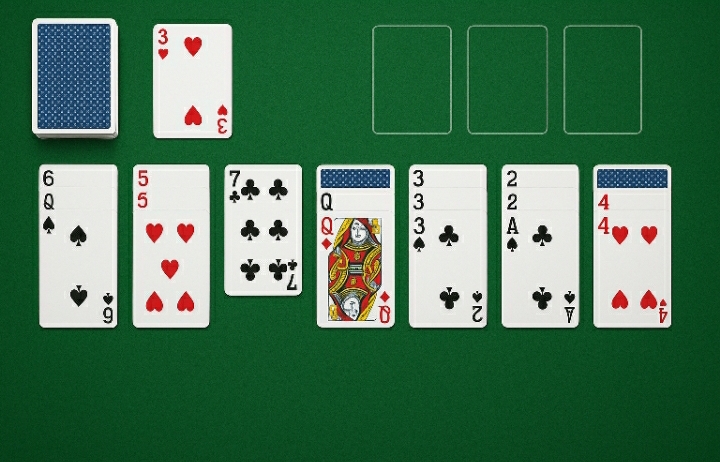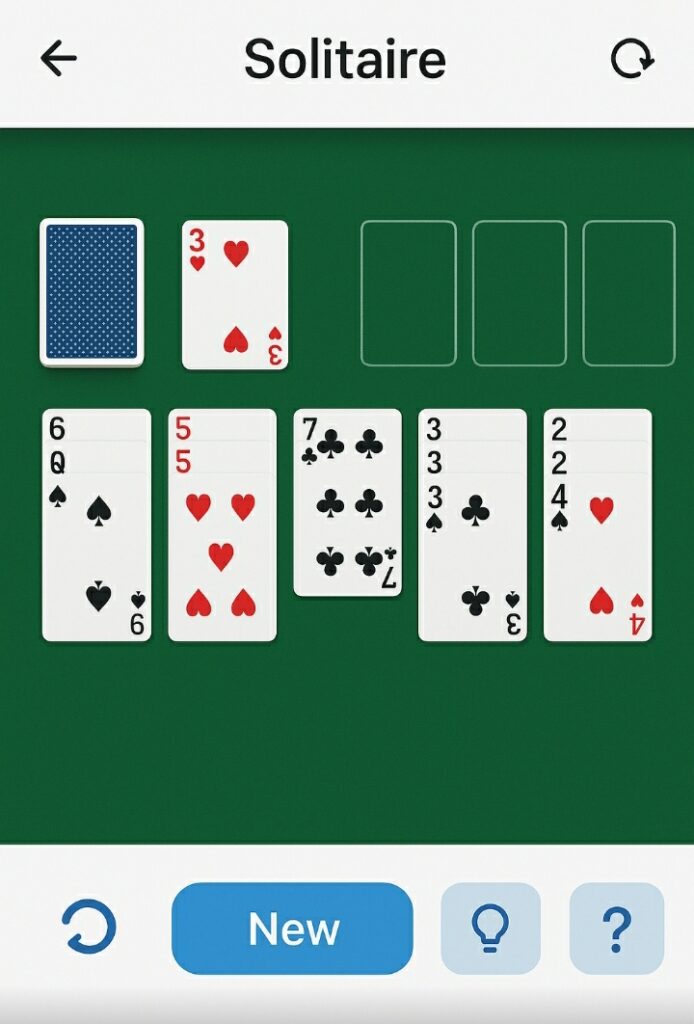Last Tuesday, I found myself trapped in an airport delay that stretched from one hour to four. With my laptop battery dying and WiFi acting up, I turned to the one reliable companion that’s never let me down—Klondike Solitaire on my phone. What started as a way to kill time became a fascinating dive into strategy, patience, and the surprising complexity behind those simple-looking card stacks.
Exploring Klondike Solitaire isn’t just about moving cards around; it’s about understanding a game that has captivated players for over a century. Whether you’re a complete beginner wondering how those seven columns work, or someone looking to improve your win rate beyond the typical 10-15%, this guide will transform your approach to the world’s most popular solitaire variant.
You’ll discover the essential rules that govern every move, proven strategies that separate casual players from consistent winners, and the best digital apps that bring this classic game into the modern era with style and sophistication.
The Foundation: Understanding Klondike Solitaire Rules
Basic Game Setup and Objective
Klondike Solitaire uses a standard 52-card deck arranged in a specific tableau that might look random but follows precise rules. The game begins with seven columns of cards, with the first column containing one card (face-up), the second column containing two cards (one face-down, one face-up), and so on until the seventh column has seven cards with only the top card visible.
Your mission? Move all 52 cards to four foundation piles—one for each suit—arranging them from Ace to King. Sounds simple, but the devil lives in the details of how you can manipulate those tableau columns and when to flip cards from your stock pile.

Legal Moves and Card Interactions
The beauty of Klondike lies in its movement restrictions that create the game’s strategic depth. In the tableau, you can only place cards in descending order with alternating colors—a red 7 can only go on a black 8, while a black Queen can only be placed on a red King. When you reveal face-down cards by moving the cards above them, new possibilities emerge.
Empty tableau columns become valuable real estate where only Kings can be placed, opening up cascading opportunities for reorganization. Meanwhile, the foundation piles build upward in suit from Ace to King, and once cards land there, they’re generally committed (though some versions allow you to pull them back if needed).
The Stock Pile Strategy
Your stock pile—those face-down cards in the upper left—can be your best friend or worst enemy. Most versions let you cycle through these cards three at a time, though some purists prefer the more challenging one-card draw. The key insight? Don’t rush to use every stock card immediately. Sometimes holding onto a card for the right moment makes the difference between victory and starting over.
Winning Strategies: Beyond Basic Play
The Column Management Philosophy
After analyzing hundreds of games, successful players share one common trait: they think three moves ahead. Before moving any card, ask yourself these questions: “What card will this reveal?”, “Will this create or eliminate future opportunities?”, and “Am I blocking myself from accessing buried cards?”
The most critical strategic principle involves managing your longest columns first. Those towering stacks of face-down cards aren’t just obstacles—they’re treasure chests of hidden opportunities. Prioritizing moves that reveal buried cards often proves more valuable than making obvious foundation plays.
Advanced Tactical Approaches
| Strategy Type | When to Use | Success Rate Impact |
|---|---|---|
| Foundation Building | When it doesn’t block tableau moves | +15% win rate |
| Column Clearing | With buried Aces or Kings | +20% win rate |
| Stock Conservation | Early game management | +12% win rate |
| King Placement | Strategic empty column use | +18% win rate |
The foundation timing paradox catches many intermediate players. While moving cards to foundations feels like progress, premature foundation building can trap essential cards you’ll need for tableau manipulation. A red 3 might serve you better in the tableau, helping to build sequences, rather than rushed to its foundation pile.
Reading the Hidden Information
Experienced players develop an intuition for reading incomplete information. When you see a face-down card beneath a black 6, start mentally preparing for the possibility of that hidden card being a red 7 or the Ace of Spades your foundation needs. This probabilistic thinking transforms how you evaluate potential moves.
Best Klondike Solitaire Apps: Digital Excellence
Microsoft Solitaire Collection (Windows/Mobile)
Microsoft’s modern interpretation deserves its reputation as the gold standard. The daily challenges keep gameplay fresh, while the hint system helps newer players learn optimal strategies without feeling patronized. The achievement system adds just enough gamification to maintain long-term engagement without overwhelming the core experience.
What sets it apart is the smooth animation system and the ability to customize everything from card backs to background themes. The statistics tracking helps you monitor improvement over time, showing win percentages and average game times that reveal your developing skills.
Solitaire by MobilityWare (iOS/Android)
This app excels at balancing simplicity with depth. The interface feels intuitive from the first tap, while power-user features like unlimited undos and auto-complete options satisfy advanced players. The daily challenges provide structured goals, and the hint system offers just enough guidance without solving puzzles for you.
The app’s strength lies in its understanding of mobile gaming sessions—games save automatically, and you can pause mid-game without losing progress. For commuters and casual players, this flexibility proves invaluable.

Spider Solitaire by Brainium Studios
While primarily known for Spider Solitaire, Brainium’s Klondike variant deserves recognition for its focus on the fundamentals. No flashy distractions, no intrusive advertising—just pure, well-implemented Klondike gameplay with responsive touch controls and pleasant visual design.
The app shines in its attention to detail: card movements feel natural, the undo function works seamlessly, and the overall experience prioritizes gameplay over monetization gimmicks.
Common Mistakes and How to Avoid Them
The Rush to Foundations Trap
Beginning players often move cards to foundations the moment they become available, thinking this represents progress. However, premature foundation building frequently blocks future tableau moves. That 4 of Hearts might be more valuable staying in the tableau, helping you build down from a 5 of Spades, rather than immediately joining its foundation pile.
Neglecting Empty Columns
Empty tableau columns represent the most powerful tool in Klondike Solitaire, yet many players fill them hastily with the first available King. Strategic players treat empty columns like premium real estate, waiting for the right King that unlocks the most buried cards or creates the longest building sequences.
Stock Pile Mismanagement
The stock pile requires patience and planning. Cycling through it carelessly, grabbing every playable card without considering consequences, often leads to dead-end situations. Instead, develop the discipline to pass over playable cards when better opportunities might emerge later in the cycle.
The Psychology Behind the Addiction
Why Klondike Captures Our Attention
Klondike Solitaire hits a sweet spot in cognitive engagement—complex enough to feel meaningful, simple enough to learn quickly. The game provides what psychologists call “variable ratio reinforcement,” where wins come unpredictably but frequently enough to maintain engagement. Unlike slot machines or other gambling mechanics, your decisions genuinely impact outcomes, creating a sense of agency that keeps players returning.
The Meditative Quality of Solo Play
In our hyperconnected world, Klondike offers something increasingly rare: productive solitude. The game demands attention without overwhelming complexity, creating a meditative state that many players find therapeutic. This mental respite, combined with the satisfaction of solving each puzzle, explains why millions of people have made Klondike part of their daily routines.
Conclusion
Exploring Klondike Solitaire reveals a game far richer than its simple appearance suggests. From understanding the strategic depth hidden in basic rules to leveraging modern apps that enhance the classic experience, mastering Klondike becomes a journey of continuous improvement and genuine satisfaction.
The strategies we’ve covered—column management, foundation timing, and stock pile patience—will immediately improve your win rate and game enjoyment. Whether you prefer Microsoft’s feature-rich approach or Brainium’s minimalist excellence, the right app can transform your daily Klondike sessions into moments of genuine engagement and mental exercise.
Ready to put these insights into practice? Download one of the recommended apps, try the strategic approaches we’ve discussed, and share your experiences in the comments below. Which tip made the biggest difference in your gameplay? Your insights could help fellow players discover their own path to Klondike mastery.
Frequently Asked Questions
What’s the average win rate for Klondike Solitaire? Most casual players win between 8-12% of their games, while strategic players using optimal moves can achieve win rates of 15-20%. The theoretical maximum win rate for perfectly played Klondike is estimated around 82%, though reaching this level requires computer-perfect play analyzing all possible outcomes.
Can you always win at Klondike Solitaire? No, approximately 18-20% of Klondike deals are mathematically unwinnable, regardless of player skill. However, the vast majority of losses result from suboptimal play rather than impossible deals. This balance keeps the game challenging while ensuring that improvement in strategy leads to tangible results.
What’s the difference between Klondike and other Solitaire variants? Klondike uses alternating colors in descending order for tableau building, while Spider Solitaire requires same-suit sequences. FreeCell provides complete information with all cards visible, eliminating the luck factor present in Klondike’s hidden cards. These differences create distinct strategic challenges and player preferences.
Should I play one-card or three-card draw from the stock pile? Three-card draw is the traditional version and provides better game balance, offering more strategic decisions while maintaining reasonable difficulty. One-card draw significantly increases win rates (often to 30%+ for skilled players) but reduces strategic depth. Choose based on whether you prefer challenge or higher success rates.
How can I improve my Klondike win percentage? Focus on revealing face-down cards before making foundation moves, manage empty columns strategically by waiting for beneficial Kings, and develop patience with stock pile cycling. Practice these fundamentals consistently, and you should see improvement within a few dozen games.
Are there any cheats or guaranteed winning strategies? While no cheats exist for legitimately shuffled games, you can improve odds by following optimal strategies: prioritize moves that reveal hidden cards, avoid premature foundation building when it blocks tableau options, and think several moves ahead before committing to card placements. Consistent application of these principles yields the best results.
Sources:
- Solitaire Strategy Guide – CardGameRules.com
- Mathematical Analysis of Klondike Solitaire – Stanford University Computer Science Department
- Microsoft Solitaire Collection Official Game Statistics – Microsoft Gaming Division